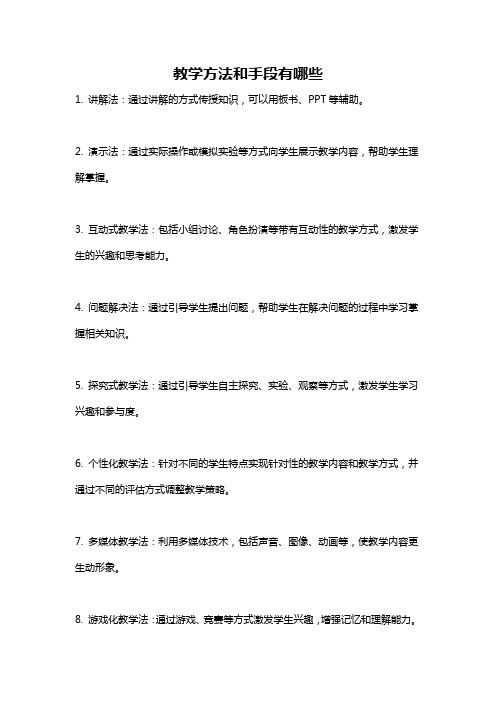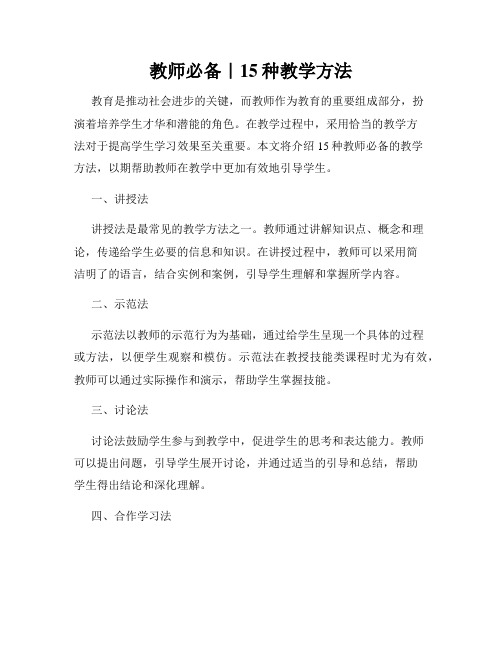教学法
十种教学方法

十种教学方法教学方法是影响教学效果的重要因素,不同的教学方法能够激发学生的学习兴趣,帮助他们更好地掌握知识。
在教学实践中,教师们可以根据学生的特点和学科内容选择适合的教学方法。
本文将介绍十种常见的教学方法,帮助教师们更好地开展教学工作。
一、讲授法讲授法是传统的教学方法之一,通过教师口头讲解、示范和解释来传授知识。
在讲授过程中,教师可以根据学生的水平和兴趣进行灵活的调整,帮助学生理解和掌握知识。
二、启发式教学法启发式教学法强调启发学生思维,鼓励他们通过探究和实践来学习知识。
教师可以提出问题、组织讨论或者设计实验,激发学生的学习兴趣和主动性。
三、案例教学法案例教学法是通过实际案例来引导学生学习,让他们通过分析和解决问题来理解知识。
案例教学能够让学生将理论知识应用到实际情境中,提高他们的学习效果。
四、小组讨论法小组讨论法是指将学生分成小组,通过讨论和合作来学习知识。
在小组讨论过程中,学生可以相互交流和分享观点,促进彼此之间的学习和进步。
五、游戏教学法游戏教学法是通过游戏形式来传授知识,让学生在轻松愉快的氛围中学习。
游戏教学能够吸引学生的注意力,增强他们的学习动力,提高学习效果。
六、实践教学法实践教学法是通过实践活动来促进学生学习,让他们在实际操作中掌握知识和技能。
实践教学能够培养学生的实践能力和创新意识,提高他们的综合素质。
七、互动式教学法互动式教学法是指教师和学生之间进行双向交流和互动,让学生在参与中学习。
通过提问、讨论和反馈,教师可以促进学生的思维发展和能力提升。
八、多媒体教学法多媒体教学法是利用多种媒体技术来进行教学,如图片、音频、视频等。
多媒体教学能够提供丰富的学习资源,激发学生的兴趣和想象力,增强学习效果。
九、项目式教学法项目式教学法是通过设计和实施项目来促进学生学习,让他们在项目实践中获取知识和技能。
项目式教学能够培养学生的实践能力和团队合作精神,提高他们的综合素质。
十、个性化教学法个性化教学法是根据学生的特点和需求量身定制的教学方式,帮助每个学生发挥潜力。
教学法有哪几种

教学法有哪几种教学法是指教师在教学过程中使用的各种方法和技巧,用于促进学生学习的过程。
根据教学者的不同理论观点和实践经验,发展出了多种不同的教学法。
以下是我对教学法的一些分类:1. 传统教学法:传统教学法是指以教师为中心的教学方式,教师在课堂上控制课程内容和学习进程,学生被动接受知识和信息。
传统教学法包括讲授法、讲义法、辅导法等。
这种教学法在过去的教育中很常见,但现今逐渐被其他更加互动和学生参与程度更高的教学法所取代。
2. 互动教学法:互动教学法重视学生的主动参与和合作学习,通过师生、学生间以及学生间的互动,促进知识和信息的交流和共享。
互动教学法包括小组讨论、合作学习、案例研究等。
互动教学法可以激发学生的积极性和主动性,培养学生的批判思维和问题解决能力。
3. 启发式教学法:启发式教学法强调学生通过自主探究和发现来获得知识,教师起到引导和辅助的作用。
启发式教学法注重培养学生的创造性思维和问题解决能力,通过激发学生的好奇心和探索欲望,提高学生的学习效果。
启发式教学法包括问题解决法、实验探究、发现学习等。
4. 情感教学法:情感教学法强调在教学过程中注重培养学生的情感态度和价值观念,关注学生的情感需求和情感变化。
情感教学法可以帮助学生建立积极的学习情感,促进学生对知识的接受和理解。
情感教学法包括情感导入、情感渗透等。
5. 多媒体教学法:多媒体教学法是指利用多媒体技术和资源进行教学活动的方法。
多媒体教学法可以通过图像、声音、文字等多个感官途径来呈现知识,使教学过程更加生动和丰富。
多媒体教学法包括使用投影仪、电子白板、教学软件等。
6. 实践教学法:实践教学法是指通过实际操作和实践经验来促进学习的方法。
实践教学法强调学生的实践能力和实践动作,通过实际操作和实践活动来加深学生对知识的理解和应用。
实践教学法包括实验教学、实地考察、实训等。
每种教学法都有其适用的场景和优势,教师在选择教学法时应根据教学目标、学生特点、课程内容等因素综合考虑。
教学方法有哪几种

教学方法有哪几种
教学方法可以分为以下几种:
1. 直观教学法:通过展示实物、图片、视频等直观的方式,让学生能够直接感知和理解知识点。
2. 互动教学法:通过教师与学生之间的互动和学生与学生之间的互动,让学生主动参与到教学过程中,增强学习的效果。
3. 讨论教学法:鼓励学生进行讨论和思考,通过对话和交流,促进深入理解和批判性思维能力的发展。
4. 上机实践教学法:让学生利用计算机等工具进行实际操作和实践,巩固和应用所学知识。
5. 游戏化教学法:将教学内容融入到游戏中,提高学生的学习兴趣和主动学习的积极性。
6. 项目式教学法:以项目为载体,让学生在实际项目中学习和应用知识,培养他们的问题解决能力和团队合作精神。
7. 情景模拟教学法:将学习内容与真实生活场景相结合,通过情景的还原和模拟,帮助学生更好地理解知识的应用。
以上所列举的教学方法都是广泛应用于教育领域的有效教学方式,根据不同的教学目标和学生特点,选择适合的教学方法可以提高教学的效果。
常见的教学方法有哪些

常见的教学方法有哪些常见的教学方法有以下几种:1. 讲授法:教师通过讲述、演示、讲解等方式向学生传授知识和技能,学生被动接受。
这种方法适用于需要大量知识点的科目,如数学、物理等,并且可以帮助学生建立基础概念。
2. 讨论法:教师引导学生参与讨论和交流,鼓励他们提出问题、发表观点和互相交流。
这种方法可以促进学生思维的活跃,提高他们的分析和判断能力,并增强他们的合作意识和沟通能力。
3. 实践法:通过实际操作、实验、实地考察等方式让学生亲身体验和参与到学习中,提高他们的实际操作能力和问题解决能力。
这种方法适用于实践性强的科目,如生物、化学等。
4. 合作学习法:组织学生进行小组合作学习,鼓励他们互相帮助、交流和合作完成学习任务。
这种方法可以培养学生的合作能力、沟通能力和团队精神,同时也可以加强他们的自主学习和解决问题的能力。
5. 个别指导法:根据学生的学习情况和水平制定个性化的学习计划,针对性地进行教学辅导。
这种方法可以更好地满足学生的个别学习需求,提高他们的学习效果和自信心。
6. 多媒体教学法:利用多种多媒体技术和工具,如投影仪、电子白板、音频视频等,将教学内容直观地呈现给学生。
这种方法可以提高学习的趣味性和吸引力,增强学生的学习动力和注意力。
7. 问题解决法:教师通过给学生提供问题和情境,引导学生自主思考、探索和解决问题。
这种方法可以培养学生的探究精神和批判性思维,激发他们的学习兴趣和创造力。
以上是常见的几种教学方法,在实际教学中可以根据学科特点和学生需求灵活运用,以提高教学效果和学生的学习质量。
常见的教学方法是教师在教学过程中常常采用的方法和手段,它们具有不同的特点和适用范围,可以根据具体的教育目标和学生的学习需求进行选择和运用。
下面将进一步介绍常见的教学方法。
8. 分组合作法:将学生按照一定的规则和要求分成小组,每个小组内的成员相互协作、互相支持,并通过合作完成任务。
这种方法可以培养学生的团队合作精神和组织协调能力,同时也能提高他们的学习兴趣和参与度。
教学方法和手段有哪些

教学方法和手段有哪些
1. 讲解法:通过讲解的方式传授知识,可以用板书、PPT等辅助。
2. 演示法:通过实际操作或模拟实验等方式向学生展示教学内容,帮助学生理解掌握。
3. 互动式教学法:包括小组讨论、角色扮演等带有互动性的教学方式,激发学生的兴趣和思考能力。
4. 问题解决法:通过引导学生提出问题,帮助学生在解决问题的过程中学习掌握相关知识。
5. 探究式教学法:通过引导学生自主探究、实验、观察等方式,激发学生学习兴趣和参与度。
6. 个性化教学法:针对不同的学生特点实现针对性的教学内容和教学方式,并通过不同的评估方式调整教学策略。
7. 多媒体教学法:利用多媒体技术,包括声音、图像、动画等,使教学内容更生动形象。
8. 游戏化教学法:通过游戏、竞赛等方式激发学生兴趣,增强记忆和理解能力。
9. 案例式教学法:通过案例分析、实践考察等方式,帮助学生更好地理解和应用所学知识。
教师必备|15种教学方法

教师必备|15种教学方法教育是推动社会进步的关键,而教师作为教育的重要组成部分,扮演着培养学生才华和潜能的角色。
在教学过程中,采用恰当的教学方法对于提高学生学习效果至关重要。
本文将介绍15种教师必备的教学方法,以期帮助教师在教学中更加有效地引导学生。
一、讲授法讲授法是最常见的教学方法之一。
教师通过讲解知识点、概念和理论,传递给学生必要的信息和知识。
在讲授过程中,教师可以采用简洁明了的语言,结合实例和案例,引导学生理解和掌握所学内容。
二、示范法示范法以教师的示范行为为基础,通过给学生呈现一个具体的过程或方法,以便学生观察和模仿。
示范法在教授技能类课程时尤为有效,教师可以通过实际操作和演示,帮助学生掌握技能。
三、讨论法讨论法鼓励学生参与到教学中,促进学生的思考和表达能力。
教师可以提出问题,引导学生展开讨论,并通过适当的引导和总结,帮助学生得出结论和深化理解。
四、合作学习法合作学习法通过组织学生小组合作完成任务,培养学生的合作意识和能力。
教师可以设定小组任务,要求学生相互合作、交流和协作,从而实现知识共享和互相促进。
五、问题解决法问题解决法强调培养学生的问题解决和创新能力。
教师可以提出现实生活中的问题,鼓励学生思考和寻找解决方法。
同时,教师还可以引导学生运用已学知识,推导和应用解决问题。
六、案例研究法案例研究法通过引入实际案例,帮助学生理解和应用理论知识。
教师可以选择真实案例,让学生深入了解案例背景、分析问题并提出解决方案,从而提高学生的分析和综合能力。
七、实践活动法实践活动法注重学生在实践中的经验积累和实际操作能力的培养。
教师可以组织实地考察、实验、模拟和实践活动,让学生亲身体验和掌握所学内容。
八、多媒体教学法多媒体教学法通过运用多媒体技术和教学资源,提供丰富多样的教学内容和形式。
教师可以结合幻灯片、视频、音频等多媒体资源呈现知识,增加学生的参与度和兴趣。
九、角色扮演法通过角色扮演,教师可以模拟真实情境,帮助学生实践和应用知识。
教学法有哪些

教学法有哪些教学法是指教师在教学过程中采用的一系列方法或策略,旨在提高学生的学习效果和兴趣。
根据教学目标的不同,教学法可分为课堂教学法、实验教学法、讲授教学法等多种类型。
以下是常见的教学法。
一、讲授教学法讲授教学法是传统的教学方法,是教师通过对知识的讲解、演示和解释来引导学生学习。
它包括讲授、演示、解答疑惑等环节,适用于知识较为抽象或理论性较强的学科,如数学、物理等。
二、讨论教学法讨论教学法是通过组织学生进行问题讨论、互相交流和讨论提出问题,鼓励学生表达自己的观点,培养学生的批判性思维和合作能力。
在讨论教学中,教师充当引导者的角色,激发学生的思考,并帮助学生总结归纳。
三、问题教学法问题教学法是通过提出问题,引导学生进行探究和发现,培养学生的问题解决能力和探索精神。
教师通过提出开放性的问题,激发学生的兴趣和思考,引导学生思考问题的方法和策略。
四、案例教学法案例教学法是通过提供真实或虚拟的案例,让学生参与分析和解决问题,培养学生的解决实际问题的能力。
学生通过研究和分析案例,学习实际应用知识的方法和技巧。
五、合作学习法合作学习法是通过组织学生进行小组合作活动,共同完成任务,培养学生的合作意识和团队精神。
学生在小组中互相合作,互相学习,通过交流和讨论,促进自己的学习。
六、实验教学法实验教学法是通过让学生亲自动手进行实验,观察和记录实验现象,培养学生的实际操作能力和实验设计能力。
教师在实验过程中引导学生思考和总结,加深他们对知识的理解。
七、情景教学法情景教学法是通过创设情境和场景,让学生进行情境角色扮演或模拟实践,加深对知识的理解和应用。
学生通过身临其境的情景,能更好地感受和理解知识。
除了上述常见的教学法,还有个别化教学法、探究教学法、游戏教学法等多种教学方法,每种方法都有其适用的领域和特点。
在实际教学中,教师可以根据学科特点、学生需求和教学目标选择合适的教学法,并结合多种教学方法进行灵活组合,提高教学效果和学生学习质量。
教学方法有哪些

教学方法有很多种,以下是一些常见的教学方法:
1. 讲授法:教师通过讲解、讲述等方式传授知识,学生通过听讲、阅读等方式接受知识。
2. 讨论法:教师组织学生分小组讨论,引导学生进行探究、合作,让学生在交流中共同解决问题,加深对知识和问题的理解。
3. 读书指导法:教师介绍学生一些书籍和参考书,让学生在自行阅读中获得知识、巩固知识、培养学生自学能力的方法。
4. 直观演示法:教师在课堂上展示各种实物、直观的教具或进行示范性实验,让学生通过观察、触摸等方式直接感知知识。
5. 参观教学法:组织学生参观,对参观地进行观察、调查、研究学习的方法。
6. 练习法:在教师的指导下进行各种练习,巩固知识、运用知识、形成技能技巧。
7. 任务驱动法:教师布置任务,学生在完成任务的过程中进行探究、合作,培养解决问题的能力。
8. 现场指导法:教师到学生实习或实践的现场进行指导,帮助学生将理论知识转化为实践操作能力。
除了以上教学方法,还有很多其他的教学方法,不同的教学方法适用于不同的学科和教学目标。
在选择教学方法时,需要根据实际情况进行选择和调整。
- 1、下载文档前请自行甄别文档内容的完整性,平台不提供额外的编辑、内容补充、找答案等附加服务。
- 2、"仅部分预览"的文档,不可在线预览部分如存在完整性等问题,可反馈申请退款(可完整预览的文档不适用该条件!)。
- 3、如文档侵犯您的权益,请联系客服反馈,我们会尽快为您处理(人工客服工作时间:9:00-18:30)。
3.1
A brief history of foreign language teaching in China Foreign language teaching before 1978 The development of ELT since 1978 (five phases) A phase of restoration (1978-1985) A phase of rapid development (1986-1992) A phase of reform (1993-2000) A phase of innovation from 2000
Before 1978
Since 1949
In the first 15 years, Russian was the predominant foreign language.
In the early 1960s
Russian
English
The reason: the diplomatic breakdown between China and the former USSR. Because of such reason, many teachers had to transfer their subject major from Russian to English.
The National English Curriculum
English Department E0901 No.22 高书敏
Aims of the Unit
In this unit we are going to focus on the following topics
1. A brief history of foreign language teaching in China. 2. Designing principles for the National English Curriculum. 3. Goals and objectives of English language teaching. 4. Design of the National English Curriculum. 5. Performance standards for different levels of competence. 6. Challenges facing English language teachers.
With these two journals, teaching ideas, lesson plans, supplementary teaching materials as well as discussions on the theoretical and practical issues on foreign language teaching were made accessible to teachers from all over the country.
Reform
1993-2000
The reason of the reform Rapid social and economic development The development in the policy of nine-year compulsory education The introduction of the communicative approach in language teaching
3.2 Designing principles for the National English Curriculum
TASK 1
The following are the six designing principles for the National English Curriculum for Nine-year Compulsory Education. Match each heading from the left column with the elaboration on the right.
• The word “communication” was first used in the objectives of teaching in 1993.
Innovation
from 2000 • This phase is characterized by a firm and urgent call from the government for quality-oriented education. Three areas need to be addressed.
Page 45
3.4 Design of the National English Curriculum
TASK 5
Study the design of the new curriculum shown below. Discuss the significant features of the design. Share your ideas with other students. Then based on an understanding of the overall aim and the design of the new English curriculum, try to list some characteristics of the new curriculum compared with the previous syllabi.
1986-1992
English syllabus for secondary schools was based on the experiences of teaching in the past years and on the integration of current international theories on language teaching and learning. English teaching should not only focus on developing students’ knowledge about the language, but also developing students’ cognitive ability, positive attitude, as well as personality.
Restoration
1978-1985
The general aims and requirement of teaching focused on the study of basic phonetics and grammar, as well as a certain amount of words. Audioligualism The textbook was based on the principles of audioligualism with one part characterized by oral and written drills of sentence patterns, another part concentrated on literacy, principally reading texts to be learned through grammar-translation. Two journals page 39
Page 42
3.3 Goals and objectives of English language teaching
TASK 2
The following table provides description of teaching goals from different English syllabuses since 1978 as well as the goals stated in the new National English Curriculum. Study them carefully and discuss the differences among them. What are the underlying assumptions and beliefs reflected in each of them?
First, there was an overemphasis on the delivery of knowledge about the language while ignoring the development of students’ language ability. Secondly, there was a lack of connection between different stages of schooling. Thirdly, little allowance was made for catering individual learner differences. Fourthly, assessment was done mainly using paper-and –pencil tests focusing mainly on language knowledge, giving little attention to the assessment of language ability, and affective gains. Four steps were taken to ensure a smooth transition to the New National English Curriculum in 2005 (page 41)
Page 45
3.4 Design of the NatSK 4
Work in groups. Discuss the following questions: When did you start learning English? If you started learning English from the primary school, did you continue with English based on what you have learned when you entered junior high school or did you have to start from the beginning again? How did you feel about your experience?
